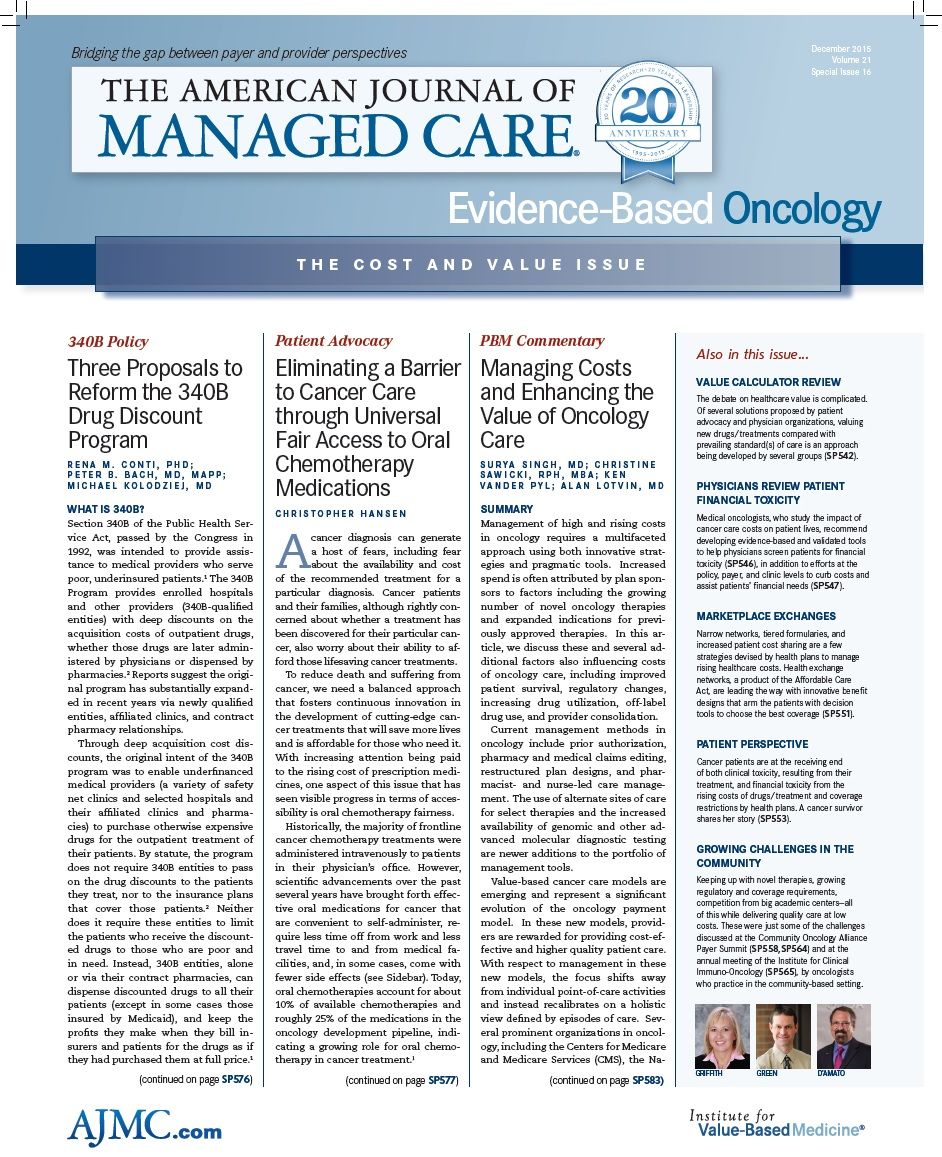Publication
Article
Evidence-Based Oncology
Maximizing Value of Freestanding and Outpatient Hospital Setting in Cancer Care Delivery
Author(s):
A unique collaboration between 21st Century Oncology and Lee Memorial Hospital showed marked improvements in efficiencies, care, and patient experience.
The cancer care environment today is defined largely by medical in­novations. No matter the setting, patients are exposed to physicians using pioneering treatments. As a result, health outcomes are better than ever and surviv­al rates are rising for almost every form of the disease. The 5-year survival rate for all cancers has increased by 20% over the past 4 years.1 Such positive statistics, which manifest themselves in the form of lives saved, suggest something quite vital: When it comes to cancer, we are finally getting the science and subsequent ther­apies right. And with each subsequent biomedical discovery, we put ourselves on a path towards solutions once thought impossible.
Even as science races forward, break­throughs still take time. Therefore, it is imperative that we supplement critical areas like biomedical innovation with equivalent advances in care delivery to reform the way physicians operate—an­ticipating powerful outcomes. Perhaps most importantly, changes to the effi­ciency of cancer care—unlike changes to the medicine or technology we use— can be implemented immediately. In the short run, structural and procedural changes are the most effective tools to improve health outcomes and could do the most to provide better value and low-cost cancer treatment.
Ultimately, there is a simple way to bolster the efficiency of cancer care: collaboration. Although this may seem obvious, collaboration in healthcare is no simple task. In most cases, oncolo­gists, treating the same patient, operate across a myriad of specialties in dispa­rate settings, resulting in minimal com­munication and lack of a unified vision for a patient’s course of care. Addition­ally, there are consistent gaps in care coordination among cancer specialists, diagnostic radiologists, and pathologists. This system leads to obvious inefficien­cies, such as repeated and unnecessary tests. It also prevents patients from re­ceiving the highest quality care following a cancer diagnosis.
Quite simply, collaboration would eliminate inefficiencies—saving critical time, improving patient outcomes, and cutting system costs. Therefore, over the past 4 years, we at 21st Century Oncology and Lee Memorial Health System have put ideas into action, working together to establish a multidisciplinary breast can­cer clinic in Lee County, Florida.
Our goal was to eliminate the clutter of cancer care and create a single, uni­fied breast cancer treatment center that combined the best parts of a freestand­ing oncology setting and the outpatient hospital environment. Just 2 short years after initiating the project, we were able to achieve a National Accreditation Pro­gram for Breast Centers certification. Our hope is that our experience can gen­erate a replicable model of collaboration across all spectrums of cancer care.
IMPROVING QUALITY OF CARE THROUGH COLLABORATION
The process began with the creation of a multidisciplinary Breast Program Lead­ership Team Committee, composed of physicians (including radiation oncolo­gists), breast fellowship—trained surgeons, general surgeons, and radiologists. It also included a chief administrative officer, a medical director, 2 breast cancer navi­gators, and a cancer registrar. Following multiple rounds of deliberations, experts experienced with the local patient popu­lation drafted comprehensive plans for a new breast cancer clinic that would effec­tively integrate radiation oncology, sur­gery, and medical oncology.
Thus far, the results have been very en­couraging and measurable in key areas. Since the establishment of the clinic, we have witnessed a significant reduction in the “screening-to-call-back” average, which essentially measures the time pa­tients wait for test results. Before oncol­ogy services were unified in the multidis­ciplinary clinic, patients were forced to wait an average of 12.5 days for screening results; subsequently, the average fell to 6.5 days. We witnessed an even more dra­matic reduction in the “screening-to-diag­nosis” average—9.55 days compared with a staggering 34 days prior to unification. In other words, even in its nascent stages, patients were reaping the rewards of inte­grated care.
In addition to strengthening quality of care, we have been able to conduct 2 quality improvement studies in the mul­tidisciplinary setting. We first evaluated genetic testing and clinical management in the community hospital setting among breast cancer patients less than 40 year. The results ultimately signaled a need for increased referrals to genetic counselors for women under age 40 years, a change that we subsequently integrated within our treatment process. The second study indicated that magnetic resonance imag­ing (MRI) plays a fundamental role in de­tecting additional disease in biopsy-prov­en breast cancer.
Based on the results, we have now ensured that all appropriate clinic patients will have a breast MRI prior to surgery. Once again, patients gained an immediate benefit from innovations in the care setting.
These developments in the efficiency of care delivery and effectiveness of treat­ment significantly bolster the value of cancer care and allow patients to seek much improved treatment, faster. Nota­bly, multidisciplinary care also has the po­tential to reduce costs through reductions in avoidable medical events. Whereas the available data is not sufficient to con­duct a cost-benefit analysis of the qual­ity improvement program (cost analysis requires 2 years to allow medical events and their related costs to fully declare themselves), this type of analysis is defi­nitely planned.
EBO
In the end, our model of collaboration and innovation was effective for treat­ing a specific class of cancer in a narrow geographic region. However, our experi­ence suggests that expanding multidis­ciplinary care could make a difference for countless Americans. Thus, in our opinion, it is time to invest in greater care coordination in oncology, as a whole, and facilitate a dynamic path towards better, cost-effective cancer care.
Constantine Mantz, MD, is chief medical officer of 21st Century Oncology.
The venture discussed in this article is a successful collaboration of 21st Century Oncology with the Lee Memorial Health System.
REFERENCE
1. Cancer facts and figures 2015. American Cancer Society website. http://www.cancer.org/research/cancerfactssta­tistics/cancerfactsfigures2015/index. Accessed October 21, 2015.







